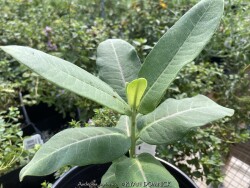

***Description for this perennial available with future update!*** Asclepias syriaca is also known as Common Milkweed.
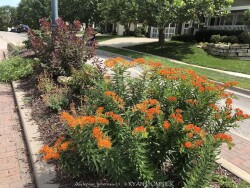

Orange Butterfly Milkweed (Asclepias tuberosa) is a native wildflower with bright orange flowers occurring mostly in dry open habitats and is very common in the prairies and grasslands of the Midwest and Great Plains. Common in Kansas, this beautiful native wildflower is also found from Maine to South Dakota to the desert southwest to Florida. In ideal locations established Butterfly Weeds are very showy with multiple flowering stems spreading across the two foot high plant. Mature plants also have a deep tap root that extends down a foot or more allowing them superb drought tolerance. This rugged species thrives in sunny locations, in dry sandy soil or well-drained loam. More permanent locations include limestone bluffs, rocky prairies, and Great Plains. This wildflower also colonizes readily with wind blown fluffy seeds and will grow under the mower blades sometimes completing their flowering before yearly mowing along state highways. Foliage is often green, upright and attractive. Flowering is long lasting usually 4-6 weeks with interesting seed pods developing later. These eventually open and seeds float away. Reseeding is rare in the garden as mulch will generally eliminate that possibility. In the landscape, Orange Butterfly Weed can be used in any dry soil situation including berms, hot south or west side of the house, or any other full sun area. These will grow in poor rocky, sandy or clayish soils and even rich organic soils as a beautiful flowering annual. With our average 40 inches of rain per year in eastern Kansas, extra irrigation is not recommended. When used as an annual with irrigation and rich garden soil, you can expect the amazing growth and summer flowering followed by a probable root rot in the winter. Orange Butterfly Weed can be planted in parking lot medians and other hell strips as a very durable groundcover. Orange Butterfly Weed can also thrive in an above-ground perennial planter (with appropriate potting soil) year-round surviving the winter coldness in Eastern Kansas (zone 6a/5b). In any situation, combine with any other flower colors except orange. There is quite a lot of diversity within the species so plants from different locales will have different foliage and flower shades adapted to the site. Flower color can range from almost red to pure yellow and everything in between.
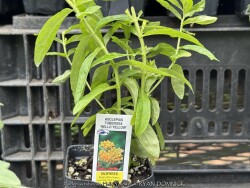

Orange Butterfly Milkweed (Asclepias tuberosa) is a native wildflower with bright orange flowers occurring mostly in dry open habitats and is very common in the prairies and grasslands of the Midwest and Great Plains. Common in Kansas, this beautiful native wildflower is also found from Maine to South Dakota to the desert southwest to Florida. In ideal locations established Butterfly Weeds are very showy with multiple flowering stems spreading across the two foot high plant. Mature plants also have a deep tap root that extends down a foot or more allowing them superb drought tolerance. This rugged species thrives in sunny locations, in dry sandy soil or well-drained loam. More permanent locations include limestone bluffs, rocky prairies, and Great Plains. This wildflower also colonizes readily with wind blown fluffy seeds and will grow under the mower blades sometimes completing their flowering before yearly mowing along state highways. Foliage is often green, upright and attractive. Flowering is long lasting usually 4-6 weeks with interesting seed pods developing later. These eventually open and seeds float away. Reseeding is rare in the garden as mulch will generally eliminate that possibility. In the landscape, Orange Butterfly Weed can be used in any dry soil situation including berms, hot south or west side of the house, or any other full sun area. These will grow in poor rocky, sandy or clayish soils and even rich organic soils as a beautiful flowering annual. With our average 40 inches of rain per year in eastern Kansas, extra irrigation is not recommended. When used as an annual with irrigation and rich garden soil, you can expect the amazing growth and summer flowering followed by a probable root rot in the winter. Orange Butterfly Weed can be planted in parking lot medians and other hell strips as a very durable groundcover. Orange Butterfly Weed can also thrive in an above-ground perennial planter (with appropriate potting soil) year-round surviving the winter coldness in Eastern Kansas (zone 6a/5b). In any situation, combine with any other flower colors except orange. There is quite a lot of diversity within the species so plants from different locales will have different foliage and flower shades adapted to the site. Flower color can range from almost red to pure yellow and everything in between. Yellow Butterfly Flower / Milkweed (Asclepias tuberosa 'Hello Yello') is a yellow flowering vegetatively propagated strain.
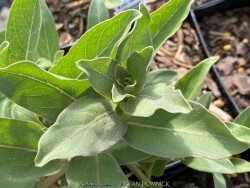

***Description for this perennial available with future update!*** Asclepias viridis is also known as Green Flowering Native Milkweed.
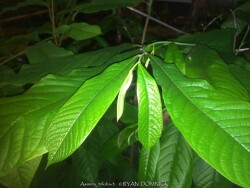

Paw Paw (Asimina triloba) is a tropical looking native understory fruit tree with large green leaves and delicious fruits. Flowers are born on old wood in the early spring and the maroon color is common of flowers meant to attract flies for pollination. Foliage is up to 12 inches long and turns a brilliant yellow in autumn for a couple weeks before falling. If cross pollination occurs, delicious fruits are produced in small clusters. The texture is custard like and taste is a mix between banana, mango, and hint of pineapple. Fruit is very fragile upon ripening and will fall to the ground and splat or be quickly devoured by animals. It is suggested that you put fruit nets around the clusters of fruit or harvest a few days earlier and allow to ripen inside. Fruit is rarely commercially available due to its fragility and short shelf-life. Cleaned fruit may be peeled frozen with seed intact: they can be picked out much easier when thawed out again Paw Paw may be eaten fresh, baked into desserts, or made into ice cream. Paw Paw is native to a large geographical area over eastern United States including Kansas. In the wild, Paw Paw grows in moist rich forest valleys in full to part shade. Best fruiting specimens can also be found on the edge of woodland or clearing in rich soil. Paw Paw tree colonies slowly spread by rhizomes and seem to occupy the forest understory sometimes for decades or centuries waiting for an opening to allow sunlight in. If a large canopy tree (such as an oak) dies or wind storm rolls through clearing a patch, new sunlight and an opening in the canopy occurs paving the way for sexual reproduction to take place (fruits) Paw Paw is somewhat tolerant of poorly drained soil's including clay but growth will be much slower. Interestingly, Paw Paws will tolerate and even need full sun when older to produce fruit. However, young saplings will quickly die in full sun from leaf burn and drought stress. If a tree is at least 4 to 6 tall and is planted in rich soil and full sun with regular irrigation, it will probably be fine. With these growing conditions, trees may grow at a median growth rate instead of slow, putting up 1 to 2 feet of new growth per year. If you have the right conditions for a Paw Paw tree, it should definitely be a part of your landscape whether you are growing for fruit production or not. There are dozens on improved cultivars available now days. In our Lawrence, KS display gardens, we are trialing several of these improved fruiting cultivars from Forrest Keeling Nursery in Missouri.


Paw Paw (Asimina triloba) is a tropical looking native understory fruit tree with large green leaves and delicious fruits. Flowers are born on old wood in the early spring and the maroon color is common of flowers meant to attract flies for pollination. Foliage is up to 12 inches long and turns a brilliant yellow in autumn for a couple weeks before falling. If cross pollination occurs, delicious fruits are produced in small clusters. The texture is custard like and taste is a mix between banana, mango, and hint of pineapple. Fruit is very fragile upon ripening and will fall to the ground and splat or be quickly devoured by animals. It is suggested that you put fruit nets around the clusters of fruit or harvest a few days earlier and allow to ripen inside. Fruit is rarely commercially available due to its fragility and short shelf-life. Cleaned fruit may be peeled frozen with seed intact: they can be picked out much easier when thawed out again Paw Paw may be eaten fresh, baked into desserts, or made into ice cream. Paw Paw is native to a large geographical area over eastern United States including Kansas. In the wild, Paw Paw grows in moist rich forest valleys in full to part shade. Best fruiting specimens can also be found on the edge of woodland or clearing in rich soil. Paw Paw tree colonies slowly spread by rhizomes and seem to occupy the forest understory sometimes for decades or centuries waiting for an opening to allow sunlight in. If a large canopy tree (such as an oak) dies or wind storm rolls through clearing a patch, new sunlight and an opening in the canopy occurs paving the way for sexual reproduction to take place (fruits) Paw Paw is somewhat tolerant of poorly drained soil's including clay but growth will be much slower. Interestingly, Paw Paws will tolerate and even need full sun when older to produce fruit. However, young saplings will quickly die in full sun from leaf burn and drought stress. If a tree is at least 4 to 6 tall and is planted in rich soil and full sun with regular irrigation, it will probably be fine. With these growing conditions, trees may grow at a median growth rate instead of slow, putting up 1 to 2 feet of new growth per year. If you have the right conditions for a Paw Paw tree, it should definitely be a part of your landscape whether you are growing for fruit production or not. There are dozens on improved cultivars available now days. In our Lawrence, KS display gardens, we are trialing several of these improved fruiting cultivars from Forrest Keeling Nursery in Missouri. Asimina triloba 'Mango' features exceptionally large fruit with flavorful yellow flesh. This has the most vigorous growth of pawpaw varieties. Fruit is late ripening.
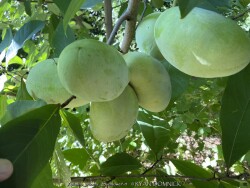

Paw Paw (Asimina triloba) is a tropical looking native understory fruit tree with large green leaves and delicious fruits. Flowers are born on old wood in the early spring and the maroon color is common of flowers meant to attract flies for pollination. Foliage is up to 12 inches long and turns a brilliant yellow in autumn for a couple weeks before falling. If cross pollination occurs, delicious fruits are produced in small clusters. The texture is custard like and taste is a mix between banana, mango, and hint of pineapple. Fruit is very fragile upon ripening and will fall to the ground and splat or be quickly devoured by animals. It is suggested that you put fruit nets around the clusters of fruit or harvest a few days earlier and allow to ripen inside. Fruit is rarely commercially available due to its fragility and short shelf-life. Cleaned fruit may be peeled frozen with seed intact: they can be picked out much easier when thawed out again Paw Paw may be eaten fresh, baked into desserts, or made into ice cream. Paw Paw is native to a large geographical area over eastern United States including Kansas. In the wild, Paw Paw grows in moist rich forest valleys in full to part shade. Best fruiting specimens can also be found on the edge of woodland or clearing in rich soil. Paw Paw tree colonies slowly spread by rhizomes and seem to occupy the forest understory sometimes for decades or centuries waiting for an opening to allow sunlight in. If a large canopy tree (such as an oak) dies or wind storm rolls through clearing a patch, new sunlight and an opening in the canopy occurs paving the way for sexual reproduction to take place (fruits) Paw Paw is somewhat tolerant of poorly drained soil's including clay but growth will be much slower. Interestingly, Paw Paws will tolerate and even need full sun when older to produce fruit. However, young saplings will quickly die in full sun from leaf burn and drought stress. If a tree is at least 4 to 6 tall and is planted in rich soil and full sun with regular irrigation, it will probably be fine. With these growing conditions, trees may grow at a median growth rate instead of slow, putting up 1 to 2 feet of new growth per year. If you have the right conditions for a Paw Paw tree, it should definitely be a part of your landscape whether you are growing for fruit production or not. There are dozens on improved cultivars available now days. In our Lawrence, KS display gardens, we are trialing several of these improved fruiting cultivars from Forrest Keeling Nursery in Missouri. Asimina triloba 'Sunflower' is a well-known, hardy selection originally from Chanute, Kansas. It ripens later than other varieties with large, flavorful fruit and is at lease partially self-fertile. Fruit has been described as tasting of mango, apricot, pineapple, banana and vanilla.
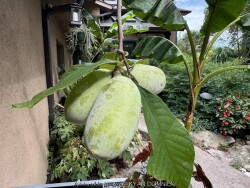

Paw Paw (Asimina triloba) is a tropical looking native understory fruit tree with large green leaves and delicious fruits. Flowers are born on old wood in the early spring and the maroon color is common of flowers meant to attract flies for pollination. Foliage is up to 12 inches long and turns a brilliant yellow in autumn for a couple weeks before falling. If cross pollination occurs, delicious fruits are produced in small clusters. The texture is custard like and taste is a mix between banana, mango, and hint of pineapple. Fruit is very fragile upon ripening and will fall to the ground and splat or be quickly devoured by animals. It is suggested that you put fruit nets around the clusters of fruit or harvest a few days earlier and allow to ripen inside. Fruit is rarely commercially available due to its fragility and short shelf-life. Cleaned fruit may be peeled frozen with seed intact: they can be picked out much easier when thawed out again Paw Paw may be eaten fresh, baked into desserts, or made into ice cream. Paw Paw is native to a large geographical area over eastern United States including Kansas. In the wild, Paw Paw grows in moist rich forest valleys in full to part shade. Best fruiting specimens can also be found on the edge of woodland or clearing in rich soil. Paw Paw tree colonies slowly spread by rhizomes and seem to occupy the forest understory sometimes for decades or centuries waiting for an opening to allow sunlight in. If a large canopy tree (such as an oak) dies or wind storm rolls through clearing a patch, new sunlight and an opening in the canopy occurs paving the way for sexual reproduction to take place (fruits) Paw Paw is somewhat tolerant of poorly drained soil's including clay but growth will be much slower. Interestingly, Paw Paws will tolerate and even need full sun when older to produce fruit. However, young saplings will quickly die in full sun from leaf burn and drought stress. If a tree is at least 4 to 6 tall and is planted in rich soil and full sun with regular irrigation, it will probably be fine. With these growing conditions, trees may grow at a median growth rate instead of slow, putting up 1 to 2 feet of new growth per year. If you have the right conditions for a Paw Paw tree, it should definitely be a part of your landscape whether you are growing for fruit production or not. There are dozens on improved cultivars available now days. In our Lawrence, KS display gardens, we are trialing several of these improved fruiting cultivars from Forrest Keeling Nursery in Missouri. Asimina triloba 'Sunflower' is a well-known, hardy selection originally from Chanute, Kansas. It ripens later than other varieties with large, flavorful fruit and is at lease partially self-fertile. Fruit has been described as tasting of mango, apricot, pineapple, banana and vanilla.
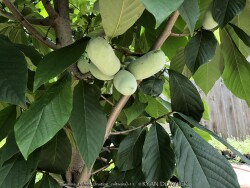

Paw Paw (Asimina triloba) is a tropical looking native understory fruit tree with large green leaves and delicious fruits. Flowers are born on old wood in the early spring and the maroon color is common of flowers meant to attract flies for pollination. Foliage is up to 12 inches long and turns a brilliant yellow in autumn for a couple weeks before falling. If cross pollination occurs, delicious fruits are produced in small clusters. The texture is custard like and taste is a mix between banana, mango, and hint of pineapple. Fruit is very fragile upon ripening and will fall to the ground and splat or be quickly devoured by animals. It is suggested that you put fruit nets around the clusters of fruit or harvest a few days earlier and allow to ripen inside. Fruit is rarely commercially available due to its fragility and short shelf-life. Cleaned fruit may be peeled frozen with seed intact: they can be picked out much easier when thawed out again Paw Paw may be eaten fresh, baked into desserts, or made into ice cream. Paw Paw is native to a large geographical area over eastern United States including Kansas. In the wild, Paw Paw grows in moist rich forest valleys in full to part shade. Best fruiting specimens can also be found on the edge of woodland or clearing in rich soil. Paw Paw tree colonies slowly spread by rhizomes and seem to occupy the forest understory sometimes for decades or centuries waiting for an opening to allow sunlight in. If a large canopy tree (such as an oak) dies or wind storm rolls through clearing a patch, new sunlight and an opening in the canopy occurs paving the way for sexual reproduction to take place (fruits) Paw Paw is somewhat tolerant of poorly drained soil's including clay but growth will be much slower. Interestingly, Paw Paws will tolerate and even need full sun when older to produce fruit. However, young saplings will quickly die in full sun from leaf burn and drought stress. If a tree is at least 4 to 6 tall and is planted in rich soil and full sun with regular irrigation, it will probably be fine. With these growing conditions, trees may grow at a median growth rate instead of slow, putting up 1 to 2 feet of new growth per year. If you have the right conditions for a Paw Paw tree, it should definitely be a part of your landscape whether you are growing for fruit production or not. There are dozens on improved cultivars available now days. In our Lawrence, KS display gardens, we are trialing several of these improved fruiting cultivars from Forrest Keeling Nursery in Missouri. Asimina triloba 'Wells' features large fruit up to one pound each have distinct banana-like flavor.
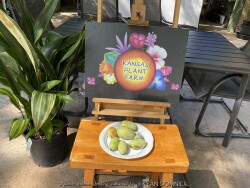

Paw Paw (Asimina triloba) is a tropical looking native understory fruit tree with large green leaves and delicious fruits. Flowers are born on old wood in the early spring and the maroon color is common of flowers meant to attract flies for pollination. Foliage is up to 12 inches long and turns a brilliant yellow in autumn for a couple weeks before falling. If cross pollination occurs, delicious fruits are produced in small clusters. The texture is custard like and taste is a mix between banana, mango, and hint of pineapple. Fruit is very fragile upon ripening and will fall to the ground and splat or be quickly devoured by animals. It is suggested that you put fruit nets around the clusters of fruit or harvest a few days earlier and allow to ripen inside. Fruit is rarely commercially available due to its fragility and short shelf-life. Cleaned fruit may be peeled frozen with seed intact: they can be picked out much easier when thawed out again Paw Paw may be eaten fresh, baked into desserts, or made into ice cream. Paw Paw is native to a large geographical area over eastern United States including Kansas. In the wild, Paw Paw grows in moist rich forest valleys in full to part shade. Best fruiting specimens can also be found on the edge of woodland or clearing in rich soil. Paw Paw tree colonies slowly spread by rhizomes and seem to occupy the forest understory sometimes for decades or centuries waiting for an opening to allow sunlight in. If a large canopy tree (such as an oak) dies or wind storm rolls through clearing a patch, new sunlight and an opening in the canopy occurs paving the way for sexual reproduction to take place (fruits) Paw Paw is somewhat tolerant of poorly drained soil's including clay but growth will be much slower. Interestingly, Paw Paws will tolerate and even need full sun when older to produce fruit. However, young saplings will quickly die in full sun from leaf burn and drought stress. If a tree is at least 4 to 6 tall and is planted in rich soil and full sun with regular irrigation, it will probably be fine. With these growing conditions, trees may grow at a median growth rate instead of slow, putting up 1 to 2 feet of new growth per year. If you have the right conditions for a Paw Paw tree, it should definitely be a part of your landscape whether you are growing for fruit production or not. There are dozens on improved cultivars available now days. In our Lawrence, KS display gardens, we are trialing several of these improved fruiting cultivars from Forrest Keeling Nursery in Missouri.
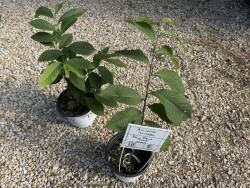

Paw Paw (Asimina triloba) is a tropical looking native understory fruit tree with large green leaves and delicious fruits. Flowers are born on old wood in the early spring and the maroon color is common of flowers meant to attract flies for pollination. Foliage is up to 12 inches long and turns a brilliant yellow in autumn for a couple weeks before falling. If cross pollination occurs, delicious fruits are produced in small clusters. The texture is custard like and taste is a mix between banana, mango, and hint of pineapple. Fruit is very fragile upon ripening and will fall to the ground and splat or be quickly devoured by animals. It is suggested that you put fruit nets around the clusters of fruit or harvest a few days earlier and allow to ripen inside. Fruit is rarely commercially available due to its fragility and short shelf-life. Cleaned fruit may be peeled frozen with seed intact: they can be picked out much easier when thawed out again Paw Paw may be eaten fresh, baked into desserts, or made into ice cream. Paw Paw is native to a large geographical area over eastern United States including Kansas. In the wild, Paw Paw grows in moist rich forest valleys in full to part shade. Best fruiting specimens can also be found on the edge of woodland or clearing in rich soil. Paw Paw tree colonies slowly spread by rhizomes and seem to occupy the forest understory sometimes for decades or centuries waiting for an opening to allow sunlight in. If a large canopy tree (such as an oak) dies or wind storm rolls through clearing a patch, new sunlight and an opening in the canopy occurs paving the way for sexual reproduction to take place (fruits) Paw Paw is somewhat tolerant of poorly drained soil's including clay but growth will be much slower. Interestingly, Paw Paws will tolerate and even need full sun when older to produce fruit. However, young saplings will quickly die in full sun from leaf burn and drought stress. If a tree is at least 4 to 6 tall and is planted in rich soil and full sun with regular irrigation, it will probably be fine. With these growing conditions, trees may grow at a median growth rate instead of slow, putting up 1 to 2 feet of new growth per year. If you have the right conditions for a Paw Paw tree, it should definitely be a part of your landscape whether you are growing for fruit production or not. There are dozens on improved cultivars available now days. In our Lawrence, KS display gardens, we are trialing several of these improved fruiting cultivars from Forrest Keeling Nursery in Missouri.
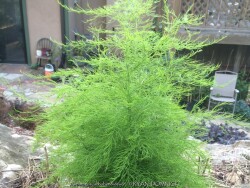

This Hardy Asparagus Fern (Asparagus schoberioides) makes a wonderful extreme fine textures accent plant in the landscape. The effect is more dramatic when combined with large leaved and bold flowering hardy tropicals. Native to the far east Asia, Asparagus schoberioides is perfectly suited to cascade down a retaining walls in Kansas landscapes. The tiny medium green foliage is flowing and but still dense. The golden fall color reminds me of Amsonia hubrichtii except with red berries! Tiny white flowers bloom in summer usually followed by red fruit. It survived -16 degrees F and a week of single digit highs in Lawrence, KS during February, 2021 without mulch.
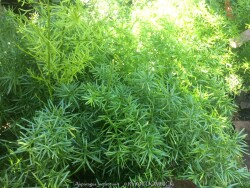

***Description for this plant available with future update!*** Asparagus setaceus is also known as Common Asparagus Fern (Tropical).
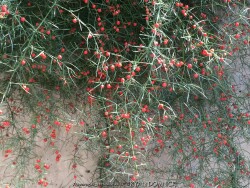

Hardy Asparagus Vine (Asparagus verticillatus) makes a wonderful extreme fine textures accent plant in the landscape. The effect is more dramatic when combined with large leaved and bold flowering hardy tropicals. Asparagus verticillatus is native to the Balkan Peninsula, Eastern Europe, Turkey, Northern Iraq, the Caucasus, Iran and Central Asia. Asparagus cochinchinensis 'Chuwang' is perfectly suited to cascade down a retaining wall in the Kansas landscape. The long twining deciduous stalks (upto 10' long) of dark green foliage turn a brilliant gold fall color. Tiny white flowers bloom in mid-May sometimes followed by loads of red fruit. The foliage stays green into the mid-20s F, serving as a perfect background for the red berries. It survived -16 degrees F and a week of single digit highs in Lawrence, KS during February, 2021 without mulch. Beautiful well-established specimens exist at the Denver Botanical Garden (zone 5b) clamoring down a 12' concrete retaining wall; what a great way to hide ugly gray concrete!
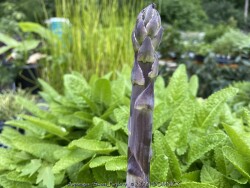

Purple asparagus is a tall extremely fine textured plant with red fruits and edible purple stocks when emerging. This plant is a great way to incorporate edible plants into your landscape design. Best of all, asparagus is a perennial which grows a bigger crown each year with more and more delicious spears. Purple asparagus spears are quite a bit fatter than it's green counterpart. Harvest 3 to 5 times and then stop by June to allow root system to recover. Plant in rich well-drained soil in full sun with mulch. Staking may be required if maintaining an organized look to your landscape. At the end of the season, simply cut down in the fall as there is no winter interest.
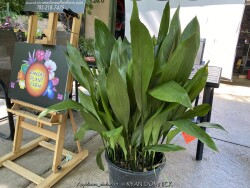

Cast-iron Plant (Aspidistra elatior) is a beautiful perennial and warmer climates for full shade. The leaves are glossy green perched on narrow stems with fat leaf blades. Unfortunately in our zone 6 Kansas climate, they cannot reliably be used as a perennial here. Most broadleaf evergreen plants are difficult to push the envelope with colder zones because evergreen leaves are more expensive to replace than for deciduous plants. (slower and requires more energy from the plant) Evergreen leaves are not intended to have to be replaced every year. In my father's zone 7a Stillwater Oklahoma garden, Cast-iron Plant can reliably be used as a perennial there but are dwarfed to about 1/2 size of normal. Anywhere south of zone 7b, count on it as a bullet-proof evergreen perennial! As a potted patio plant for full shade, they are wonderful. Grown in a raised pot, they are hardy to about 15-20° so you may be able to miss the first few frosts when moving them in for the winter. Before extreme cold (lower than 10 degrees F), they must be moved and overwintered in a dark garage or basement with monthly watering or bright window as a winter-only houseplant. Either way, they will hold up very well in the winter and maintain attractive foliage. When grown as a permanent house plant, they will last many years is grown in a bright indirect area. When Cast-iron Plant is grown as a permanent houseplant, you will need to watch for spider mites and possibly scale after a few years. Taking the whole plant outside and spraying with water a few times a year will help. Spider mites thrive and dry dusty conditions with low humidity (such as your house). Overall, Cast-iron Plants are very easy to grow hence their name. They will tolerate lower light than just about any house plant but after a few years, even this plant will decline unless given a summer growing season under a shaded tree or brighter conditions inside the house. New leaves grow about once per year and gradually the plant will need to be repotted as it is possible for them to split the container. This is a great time to divide the root system and get several new plants. This is one of our all-time favorite house plants.
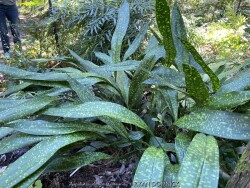

Cast-iron Plant (Aspidistra sp.) is a beautiful perennial and warmer climates for full shade. The leaves are glossy green perched on narrow stems with fat leaf blades. Unfortunately in our zone 6 Kansas climate, they cannot reliably be used as a perennial here. Most broadleaf evergreen plants are difficult to push the envelope with colder zones because evergreen leaves are more expensive to replace than for deciduous plants (slower and requires more energy from the plant). As a potted patio plant for full shade, they are wonderful. Grown in a raised pot, they are hardy to about 20-25° so you may be able to miss the first few frosts when moving them in for the winter. Before extreme cold (lower than approx.15 degrees F), they must be moved and overwintered in a dark garage or basement with monthly watering or bright window as a winter-only houseplant. Either way, they will hold up very well in the winter and maintain attractive foliage. When grown as a permanent house plant, they will last many years is grown in a bright indirect area. When Cast-iron Plant is grown as a permanent houseplant, you will need to watch for spider mites and possibly scale after a few years. Taking the whole plant outside and spraying with water a few times a year will help. Spider mites thrive and dry dusty conditions with low humidity (such as your house). Overall, Cast-iron Plants are very easy to grow hence their name. They will tolerate lower light than just about any house plant but after a few years, even this plant will decline unless given a summer growing season under a shaded tree or brighter conditions inside the house. New leaves grow about once per year and gradually the plant will need to be repotted as it is possible for them to split the container. This is a great time to divide the root system and get several new plants. This is one of our all-time favorite house plants.
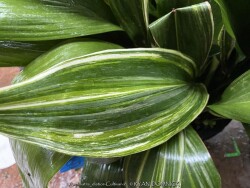

Cast-iron Plant (Aspidistra elatior cultivars) is a beautiful perennial and warmer climates for full shade. The leaves are glossy green perched on narrow stems with fat leaf blades. Unfortunately in our zone 6 Kansas climate, they cannot reliably be used as a perennial here. Most broadleaf evergreen plants are difficult to push the envelope with colder zones because evergreen leaves are more expensive to replace than for deciduous plants (slower and requires more energy from the plant). As a potted patio plant for full shade, they are wonderful. Grown in a raised pot, they are hardy to about 15-20° so you may be able to miss the first few frosts when moving them in for the winter. Before extreme cold (lower than 10 degrees F), they must be moved and overwintered in a dark garage or basement with monthly watering or bright window as a winter-only houseplant. Either way, they will hold up very well in the winter and maintain attractive foliage. When grown as a permanent house plant, they will last many years is grown in a bright indirect area. When Cast-iron Plant is grown as a permanent houseplant, you will need to watch for spider mites and possibly scale after a few years. Taking the whole plant outside and spraying with water a few times a year will help. Spider mites thrive and dry dusty conditions with low humidity (such as your house). Overall, Cast-iron Plants are very easy to grow hence their name. They will tolerate lower light than just about any house plant but after a few years, even this plant will decline unless given a summer growing season under a shaded tree or brighter conditions inside the house. New leaves grow about once per year and gradually the plant will need to be repotted as it is possible for them to split the container. This is a great time to divide the root system and get several new plants. This is one of our all-time favorite house plants.
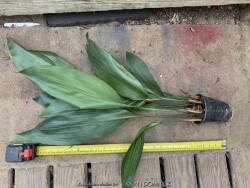

Cast-iron Plant (Aspidistra elatior) is a beautiful perennial and warmer climates for full shade. The leaves are glossy green perched on narrow stems with fat leaf blades. Unfortunately in our zone 6 Kansas climate, they cannot reliably be used as a perennial here. Most broadleaf evergreen plants are difficult to push the envelope with colder zones because evergreen leaves are more expensive to replace than for deciduous plants. (slower and requires more energy from the plant) Evergreen leaves are not intended to have to be replaced every year. In my father's zone 7a Stillwater Oklahoma garden, Cast-iron Plant can reliably be used as a perennial there but are dwarfed to about 1/2 size of normal. Anywhere south of zone 7b, count on it as a bullet-proof evergreen perennial! As a potted patio plant for full shade, they are wonderful. Grown in a raised pot, they are hardy to about 15-20° so you may be able to miss the first few frosts when moving them in for the winter. Before extreme cold (lower than 10 degrees F), they must be moved and overwintered in a dark garage or basement with monthly watering or bright window as a winter-only houseplant. Either way, they will hold up very well in the winter and maintain attractive foliage. When grown as a permanent house plant, they will last many years is grown in a bright indirect area. When Cast-iron Plant is grown as a permanent houseplant, you will need to watch for spider mites and possibly scale after a few years. Taking the whole plant outside and spraying with water a few times a year will help. Spider mites thrive and dry dusty conditions with low humidity (such as your house). Overall, Cast-iron Plants are very easy to grow hence their name. They will tolerate lower light than just about any house plant but after a few years, even this plant will decline unless given a summer growing season under a shaded tree or brighter conditions inside the house. New leaves grow about once per year and gradually the plant will need to be repotted as it is possible for them to split the container. This is a great time to divide the root system and get several new plants. This is one of our all-time favorite house plants.
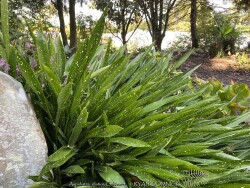

Cast-iron Plant (Aspidistra sp.) is a beautiful perennial and warmer climates for full shade. The leaves are glossy green perched on narrow stems with fat leaf blades. Unfortunately in our zone 6 Kansas climate, they cannot reliably be used as a perennial here. Most broadleaf evergreen plants are difficult to push the envelope with colder zones because evergreen leaves are more expensive to replace than for deciduous plants (slower and requires more energy from the plant). As a potted patio plant for full shade, they are wonderful. Grown in a raised pot, they are hardy to about 15-20° so you may be able to miss the first few frosts when moving them in for the winter. Before extreme cold (lower than 10 degrees F), they must be moved and overwintered in a dark garage or basement with monthly watering or bright window as a winter-only houseplant. Either way, they will hold up very well in the winter and maintain attractive foliage. When grown as a permanent house plant, they will last many years is grown in a bright indirect area. When Cast-iron Plant is grown as a permanent houseplant, you will need to watch for spider mites and possibly scale after a few years. Taking the whole plant outside and spraying with water a few times a year will help. Spider mites thrive and dry dusty conditions with low humidity (such as your house). Overall, Cast-iron Plants are very easy to grow hence their name. They will tolerate lower light than just about any house plant but after a few years, even this plant will decline unless given a summer growing season under a shaded tree or brighter conditions inside the house. New leaves grow about once per year and gradually the plant will need to be repotted as it is possible for them to split the container. This is a great time to divide the root system and get several new plants. This is one of our all-time favorite house plants.
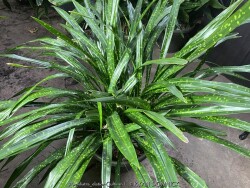

Cast-iron Plant (Aspidistra sp.) is a beautiful perennial and warmer climates for full shade. The leaves are glossy green perched on narrow stems with fat leaf blades. Unfortunately in our zone 6 Kansas climate, they cannot reliably be used as a perennial here. Most broadleaf evergreen plants are difficult to push the envelope with colder zones because evergreen leaves are more expensive to replace than for deciduous plants (slower and requires more energy from the plant). As a potted patio plant for full shade, they are wonderful. Grown in a raised pot, they are hardy to about 20-25° so you may be able to miss the first few frosts when moving them in for the winter. Before extreme cold (lower than approx.15 degrees F), they must be moved and overwintered in a dark garage or basement with monthly watering or bright window as a winter-only houseplant. Either way, they will hold up very well in the winter and maintain attractive foliage. When grown as a permanent house plant, they will last many years is grown in a bright indirect area. When Cast-iron Plant is grown as a permanent houseplant, you will need to watch for spider mites and possibly scale after a few years. Taking the whole plant outside and spraying with water a few times a year will help. Spider mites thrive and dry dusty conditions with low humidity (such as your house). Overall, Cast-iron Plants are very easy to grow hence their name. They will tolerate lower light than just about any house plant but after a few years, even this plant will decline unless given a summer growing season under a shaded tree or brighter conditions inside the house. New leaves grow about once per year and gradually the plant will need to be repotted as it is possible for them to split the container. This is a great time to divide the root system and get several new plants. This is one of our all-time favorite house plants.
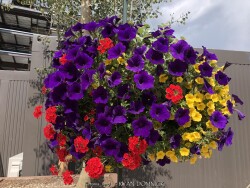

Assorted Annual Flowering Hanging Baskets offer intense color to the patio or pergola!
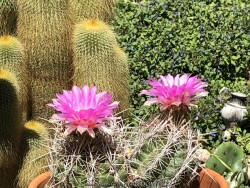

Succulents are usually spineless and grown for their beautiful shapes, color and texture. Cacti are known for their spines, unusual shapes and beautiful flowers. Both succulents and cacti store water in their fleshy tissues. And can survive long periods without water. Cacti and succulents are usually grown as a deck/patio plant or house plant in Kansas. Grow in full sun with little to no extra watering except that which comes from rainfall. Generally, plants may be brought out in Late May through Early October in our zone 6a Lawrence, KS climate. To play is safe, potted plants are best moved in before autumn leaves begin to drop and before night temperatures get below 45 degrees F. It is very important to avoid the combination of wet and cold. Move to a bright interior window over the winter with little to no watering and keep above 50 degrees F. As a winter house plant, it will look presentable all winter long with little to no waterings. As a permanent house plant, provide bright light and allow the soil to dry completely between waterings and you will get many years of carefree enjoyment. Plants grown permanently indoors may eventually begin to elongate stretching for light and lose their spine color. It can be hard to reproduce the intense UV sunlight they need when growing indoors so moving outside for the summer is best. Generally if moving outside for the summer, allow 1-2 weeks of part shade or morning sun before placing in full sun. Plants with time to acclimate will thrive in full sun but be careful not to rush it or sunburning may occur. Repotting may or may not be needed depending on how large you want the plant to grow; plants can continue to grow taller and tolerate extremely root-bound pots but may need wind bracing. If repotting, make sure to use a sharp draining low organic cactus mix with plenty of sand and perlite but avoid peat moss. The “soil” most commercial cacti are potted in to too peaty and light weight. This soil becomes hydrophobic and shrinks after becoming bone dry and difficult to re wet again. Cacti never grow in peat-based soils in nature; this “Soil” is only good for shipping because of the light weight. Potted plants are very low maintenance but watch for scale and mealybugs that may hide beneath the cover of spines. The best pest removal approach is to periodically wash the cactus off. Achieve this with a water nozzle or hose breaker turned mostly off to increase the pressure from the blast of water. This high-pressured water kills the pests without damaging the thick cactus skin. Here are some little-known or rare factoids about cacti: 1. The "spines" are actually modified leaves filled with sap at first, then quickly drying out to form the spines! 2. Many cacti have bright colored flowers that mainly attract bees, while some tubular flowering types attract hummingbirds and bats. 3. Late on the evolutionary timeline, cacti fossils are rare to non-existent. Cacti are native almost exclusively to the Americas, while succulents can include a much larger plant palette be from any dry area in the world. 4. Some cactus plants have been known to survive more than 2 years without water. 5. Some cacti first evolved in a dry climate that later became wetter again. For example: several jungle species live as epiphytes in trees to achieve the fast drainage they need.
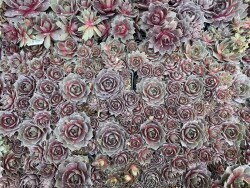

These tiny perennials and succulents produce various colored mats of foliage. In favorable conditions they can spread by runners rooting as they go; several species are valued in cultivation as groundcover for dry, sunny locations. Grow these in a rock garden, in cracks between rocks, or on top of or in a retaining wall. You may also grow in flat areas like in between stepping stones provided you used a gravelly or sandy base for the stones. Most rock garden plants will not tolerate rich moist soils as other plants or weeds will shade it out. Crown rot can occur during lengthy hot humid summer rainy periods. Most rock garden plants do not thrive indoors; aphids and spider mites seem to find them after a few months but overwintering indoors in a cool environment may work. If grown in pots and kept on the dry side, you may leave out all winter allowing to freeze solid; plants will go dormant and resume growth in the spring.
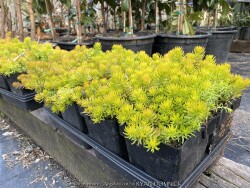

These tiny perennials and succulents produce various colored mats of foliage. In favorable conditions they can spread by runners rooting as they go; several species are valued in cultivation as groundcover for dry, sunny locations. Grow these in a rock garden, in cracks between rocks, or on top of or in a retaining wall. You may also grow in flat areas like in between stepping stones provided you used a gravelly or sandy base for the stones. Most rock garden plants will not tolerate rich moist soils as other plants or weeds will shade it out. Crown rot can occur during lengthy hot humid summer rainy periods. Most rock garden plants do not thrive indoors; aphids and spider mites seem to find them after a few months but overwintering indoors in a cool environment may work. If grown in pots and kept on the dry side, you may leave out all winter allowing to freeze solid; plants will go dormant and resume growth in the spring.


Succulents are usually spineless and grown for their beautiful shapes, color and texture. Cactus are known for their spines, unusual shapes and beautiful flowers. Late on the evolutionary timeline, cacti fossils are rare to non-existent. The "spines" are actually modified leaves! Cacti are native almost exclusively to the Americas, while succulents can include a much larger plant palette be from any dry area in the world. Both succulents and cacti store water in their fleshy tissues. They are usually grown as a patio or house plant in Kansas. In the wild, some species are hardy to below 0 degrees F. Grow in full sun with no extra watering except that which comes from rainfall. Repotting may or may not be needed depending on how large you want the plant to grow; plants can continue to grow taller and tolerate extremely root-bound pots but may need wind bracing. If repotting, make sure to use a sharp draining low organic cactus mix with plenty of sand and perlite. To play is safe, potted plants are best moved in before night temperatures get below 45 degrees F. It is important to avoid the combination of wet and cold. Move to a bright interior window over the winter with no watering and keep above freezing. As a winter house plant, it will look presentable all winter long with just no waterings. As a permanent house plant, provide bright light and allow the soil to dry between waterings for many years of carefree enjoyment. Plants grown permanently indoors may begin to elongate stretching for light and lose their spine color. It can be hard to reproduce the intense UV sunlight they need so moving outside for the summer is best. Generally if moving outside for the summer, allow 1-2 weeks of part shade or morning sun before placing in full sun. Plants with time to acclimate will thrive in full sun but be careful not to rush it or sunburning will occur. Potted plants are very low maintenance but watch for scale and mealybugs that may hide beneath the cover of spines. Some species grow well in hanging baskets!
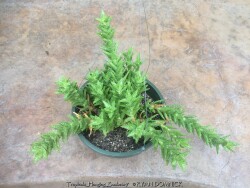

***Description for this plant available with future update!*** Assorted Tropical Hanging Baskets is also known as Assorted Tropical Hanging Baskets (Tropical).
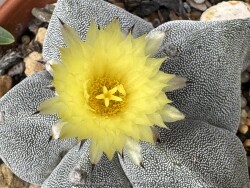

***Description for this plant available with future update!*** Astrophytum myriostigma is also known as Bishop's Cap Cactus (Tropical)>>>>> Cacti are known for their spines, unusual shapes and beautiful flowers. Both succulents and cacti store water in their fleshy tissues. And can survive long periods without water. Cacti and succulents are usually grown as a deck/patio plant or house plant in Kansas. Grow in full sun with little to no extra watering except that which comes from rainfall. Generally, plants may be brought out in Late May through Early October in our zone 6a Lawrence, KS climate. To play is safe, potted plants are best moved in before autumn leaves begin to drop and before night temperatures get below 45 degrees F. It is very important to avoid the combination of wet and cold. Move to a bright interior window over the winter with little to no watering and keep above 50 degrees F. As a winter house plant, it will look presentable all winter long with little to no waterings. As a permanent house plant, provide bright light and allow the soil to dry completely between waterings and you will get many years of carefree enjoyment. Plants grown permanently indoors may eventually begin to elongate stretching for light and lose their spine color. It can be hard to reproduce the intense UV sunlight they need when growing indoors so moving outside for the summer is best. Generally if moving outside for the summer, allow 1-2 weeks of part shade or morning sun before placing in full sun. Plants with time to acclimate will thrive in full sun but be careful not to rush it or sunburning may occur. Repotting may or may not be needed depending on how large you want the plant to grow; plants can continue to grow taller and tolerate extremely root-bound pots but may need wind bracing. If repotting, make sure to use a sharp draining low organic cactus mix with plenty of sand and perlite but avoid peat moss. The “soil” most commercial cacti are potted in to too peaty and light weight. This soil becomes hydrophobic and shrinks after becoming bone dry and difficult to re wet again. Cacti never grow in peat-based soils in nature; this “Soil” is only good for shipping because of the light weight. Potted plants are very low maintenance but watch for scale and mealybugs that may hide beneath the cover of spines. The best pest removal approach is to periodically wash the cactus off. Achieve this with a water nozzle or hose breaker turned mostly off to increase the pressure from the blast of water. This high-pressured water kills the pests without damaging the thick cactus skin. Here are some little-known or rare factoids about cacti: 1. The "spines" are actually modified leaves filled with sap at first, then quickly drying out to form the spines! 2. Many cacti have bright colored flowers that mainly attract bees, while some tubular flowering types attract hummingbirds and bats. 3. Late on the evolutionary timeline, cacti fossils are rare to non-existent. Cacti are native almost exclusively to the Americas, while succulents can include a much larger plant palette be from any dry area in the world. 4. Some cactus plants have been known to survive more than 2 years without water. 5. Some cacti first evolved in a dry climate that later became wetter again. For example: several jungle species live as epiphytes in trees to achieve the fast drainage they need.
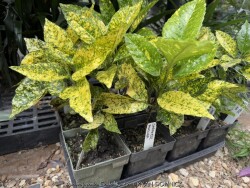

Japanese Aucuba (Aucuba japonica) is a surprisingly hardy evergreen shrub from Japan featuring dark green leaves with gold spots. Flowering and fruiting may occur in warmer climates but have not witnessed that in our zone 6a climate. Aucuba is at the northern edge of its range but will survive and reach varying heights of 1 to 3 feet. Winterkill occurs at about -5 to -10° so plan to prune off winter kill and new growth will resume in spring. In southern zones with mild winters aucuba can reach 6-8' tall, tolerating full shade and drought making it a great dry shade plant. In our Lawrence Gardens, this is possible if sited on a south exposure in full shade with winter wind protection. Rich organic soils and morning sun / filtered sun are both preferred in northern climates. Watering during the winter when dry will help broadleaf evergreen shrubs stay hydrated and maintain their winter foliage better. This jewel of the shade garden adds valuable bright green and yellow winter color giving some structure. Combine with other shade plants such as hosta, Solomon Seal, Hellebore, Barrenwort, or Coralberry. Plants in our Lawrence, KS gardens generally survive for several years and are worth the effort in the shade garden. Don't count on them getting very big so plant close together if designing with a grouping. Aucuba japonica 'Gold King' is a male form with numerous gold spots on dark green leaves.